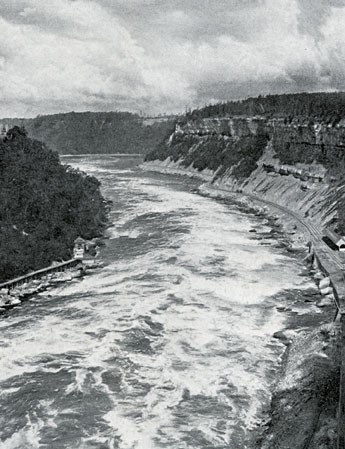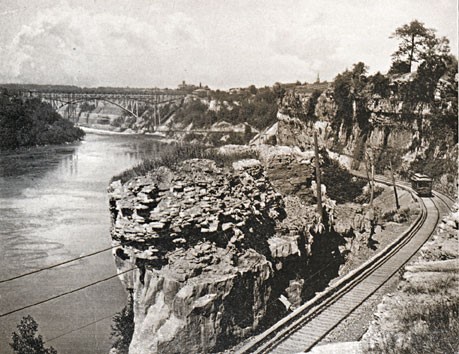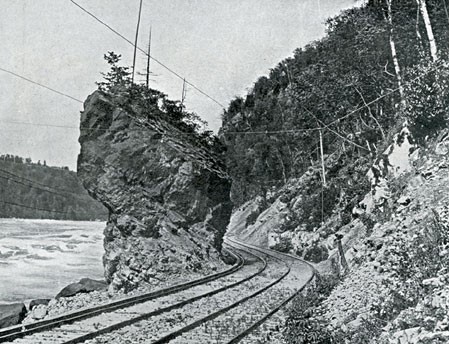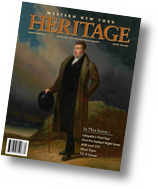In 1895, the International Railway Company (IRC, predecessor of the NFTA) bought a rail line and established the Great Gorge Route scenic attraction. This electric trolley line ran from Niagara Falls (Prospect Park) to Lewiston, NY along the banks of the Niagara River. Up to 10 cars ran at a time, carrying enthralled visitors just a few feet away from the whirlpool rapids, Devil's Hole, the Narrows, and the Giant Rock.
Below is text from a 1901 guidebook sold to Pan-American visitors. By many accounts, those visitors did indeed make their way to Niagara Falls before or after their Exposition stay.
The Great Gorge Route
The most magnificent scenic route in the world. This line is a marvel of skill and ingenuity in electric railway building; double-tracked its entire length and provided with every safety appliance known to modern railroad building, it is absolutely safe. One who simply views the Falls sees only a part of the wonders and beauties of Niagara.
Commencing at the Falls the most wonderful of river canyons, the Niagara Gorge is entered by a gentle grade on the side of the rocky gorge. Passing under the Cantilever Bridge and the New Steel Arch which span the river, the line reaches the lower level at the Whirlpool Rapids. The waters which have been slowly moving in solemn smoothness as though resting after their terrific leap, here rise like maddened horses and with irresistible forces are suddenly lashed into fury indescribable. It was in these rapids that the brave English swimmer, Captain Matthew Webb, on July 24, 1883, in a brave but foolhardy attempt to swim them, lost his life. Here is also the first Maid of the Mist was at times almost entirely submerged in making her memorable and thrilling run to Lake Ontario.
Continuing down 'the gorge in full view of this mighty, raging torrent which is rushing madly onward, the wondering passenger is presently brought into full view of the Grand Whirlpool. The scene here presented is above all others the most awe-inspiring. This great basin, which lies at the foot of the high frowning walls which line the magnificent gorge, has been formed by the action of the restless rush of waters which for ages past have been swept against its granite walls. Here the river again rests awhile, circling around in sullen whirl. Huge floating logs are sometimes seen suddenly tossing their ends high in the air, to be sucked down only a moment later into the vortex of the maelstrom . It is a weird and uncanny place. All at once the waters find their exit, and springing into motion afresh, set off again on their way to the sea. Following the course of the river, the car now slowly creeps around Niagara, curve directly opposite to which on the Canadian shore is to be seen a most remarkable rock formation. Standing out in bold relief, as if by the hand of a sculptor, may be seen the bust of a human form, known as the ''Demon of the Gorge."
Now the descent of the lower rapids is commenced. Along here are caves and many historic points. Among them the Devil's Hole, near to the wonderful giant rock, which stands like a silent sentinel: the rivulet of Bloody Run, where, in 1763 a company of British soldiers were ambushed at the top of the steep banks by a band of Seneca Indians. Out of ninety men but three escaped; the rest were either butchered or thrown over the cliff. So, still onward and downward in the valley, the cars follow the river. High on the Canadian heights towers the splendid shaft of Brock's Monument, erected by Canada to that brave English officer. Opposite on the American cliff are the ruins of old Fort Gray, whose earthworks beheld, in 1812, the battle of Queenston Heights. Between them has been erected a new suspension bridge, a graceful and substantial structure, replacing the first suspension bridge that ever spanned the Niagara Gorge, but which was destroyed by a severe storm in 1865.
Lewiston, the terminus of the Niagara Gorge Railway, is reached where tourists transfer to the steamers of the Niagara River Line, to continue their journey to Toronto or to return again by the "Great Gorge Route." The privilege to stop off at different points of interest is allowed.
Historically, the Great Gorge Route was safe, with the exception of the 1917 accident in which a car left the tracks and plunged into the river, killing around 50 passengers. The trolley line ceased in 1935, victim to the Depression and the change in tourist transportation preferences (bus and automobile). The track lines were essentially abandoned and today are used by hikers as part of the Niagara Gorge Trail.













